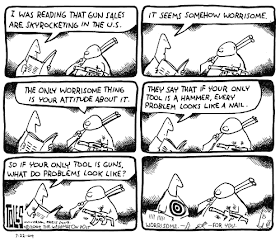John Gray, February 2012:
"...Comte
wanted his new religion to be based on science, so the temples of humanity pointed
only as far as science could reach. That is why his new church failed. The very
idea of a science-based religion is an absurdity. The value of religion is that
it points beyond anything that can be known by the methods of science, showing
us that a mystery would remain even if everything could be finally explained.
The heart of religion isn't belief, but something more like what Keats
described as negative capability: "being in uncertainties, mysteries,
doubts, without any irritable reaching after fact and reason"..."
Ned Flanders:
"Why me, Lord? Where have I gone wrong? I've always been nice to people! I don't drink or dance or swear! I've even kept kosher just to be on the safe side! I've done everything the Bible says; even the stuff that contradicts the other stuff! What more could I do?"
(The Simpsons, 'Hurricane Neddy', Season 8 Episode 8, Aired December 29, 1996)
Look at the following picture by great cartoonist Jean-Jacques Sempé.
Artist: Jean-Jacques Sempé (August 17 1932 - )
courtesy: Madhukar Dharmapurikar (मधुकर धर्मापुरीकर)
In a church, an old lady is stunned to find a mouse, with a halo around its head, is being chased by a ferocious looking cat. The outcome looks almost certain.
Unfortunately, all the details in the picture are not very clear. For instance, there are a couple of paintings on the wall of the church. And if you look closely, you will notice they depict some kind of violence.
Andrew Graham-Dixon writes in "Caravaggio A Life Sacred and Profane", 2012:
"Caravaggio’s art is made from darkness and light. His pictures present spotlit moments of extreme and often agonized human experience. A man is decapitated in his bedchamber, blood spurting from a deep gash in his neck. A man is assassinated on the high altar of a church..."
'The Beheading of St John', 1608 Location St. John's Co-Cathedral, Valletta
Artist: Caravaggio ( "In the blood gushing from the saint’s neck, Caravaggio signed his name. It is his only signature on a painting.")
In Sempe's church, it's not going to be a man but just a mouse. But in the background, there is probably a Caravaggio.
Edward Mendelson has said:
"Great institutions thrive on internal contradictions and irresolvable divisions. This has always been the case with governments and universities, and especially with religions..."
A church mouse that has earned its halo, no less, finds no mercy as it is about to breathe its last.
While reviewing 'Hunting Evil/ The Nazi War Criminals Who Escaped and the Quest to Bring Them to Justice' by Guy Walters, Deborah E.Lipstadt says:
"...The Vatican also went out of its way to protect criminals. It provided passports, refuge and other means of support for them. While the church's record during the war may be open to some debate, its record in helping the murderers escape responsibility afterward is clear, as has been documented by both Michael Phayer in "The Catholic Church and the Holocaust, 1930-1965" and Gerald Steinacher in "Nazis auf der Flucht..."
Is Sempe's church protecting the killer cat?
Mr. Graham-Dixon says in the book quoted above:
"...The second half of the sixteenth century witnessed a widespread call to order – a movement intended to take religious art back to the values of an earlier and supposedly purer time. Carlo Borromeo was at its forefront. As well as containing recommendations of every kind about church architecture and decoration, his Instructiones set out his views on art with typical forthrightness. No animals or other distracting details should be included, unless actually mentioned in the biblical text that the artist had been instructed to illustrate. In the seventeenth chapter of his book, devoted to the correct representation of sacred events, Borromeo determined the appropriate fines and punishments for artists who failed to meet the strictest standards of decorum. In Milan, errant artists as well as heretics were liable to come to the attentions of the archbishop’s famiglia armata. No painter could be in any doubt about what was required of him. Images should be clear and direct. It was the job of art simply to educate spectators and move them to penance..."
In Sempe's picture, there are two animals...there are lots of distracting details...even then Sempe's picture perhaps moves us to penance!













